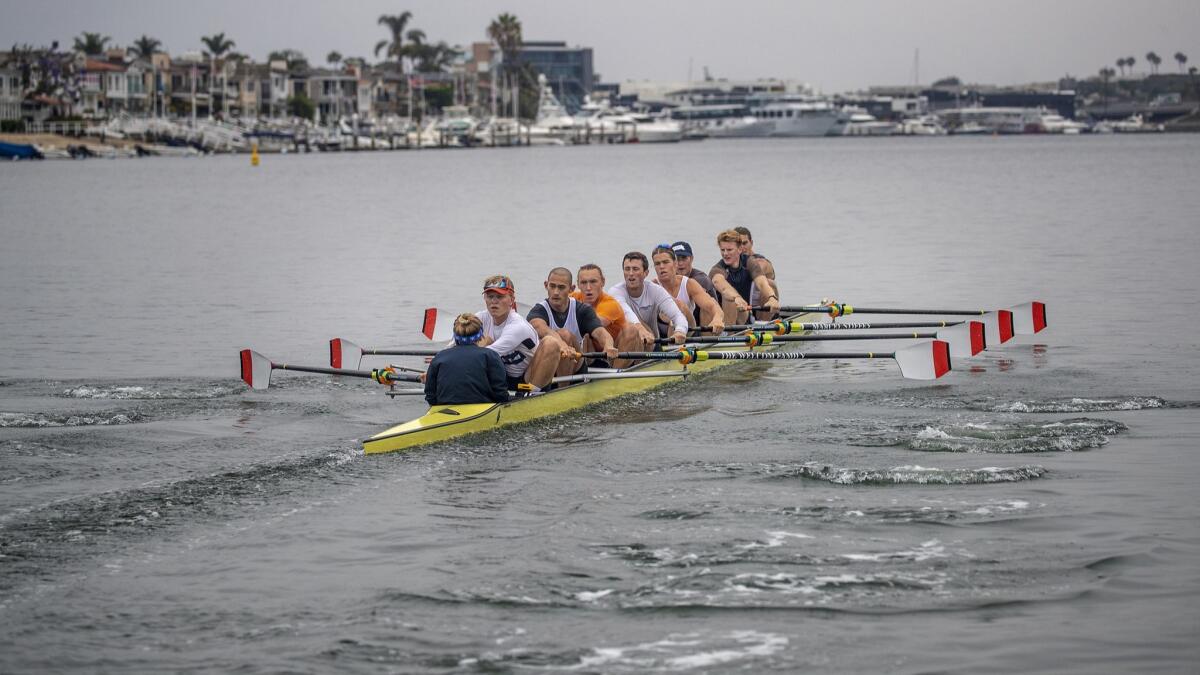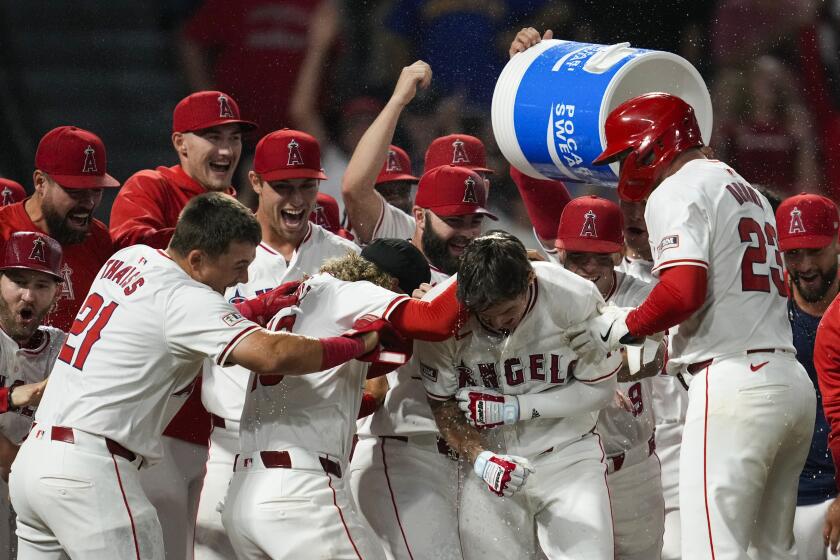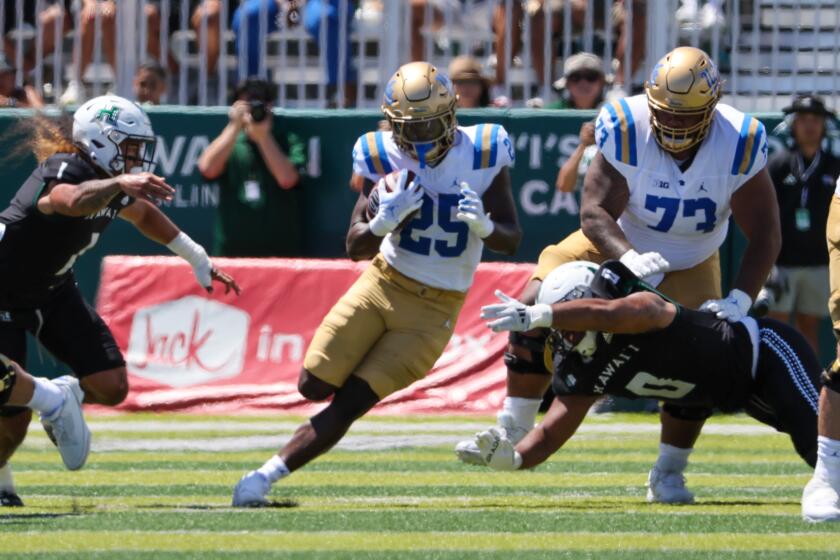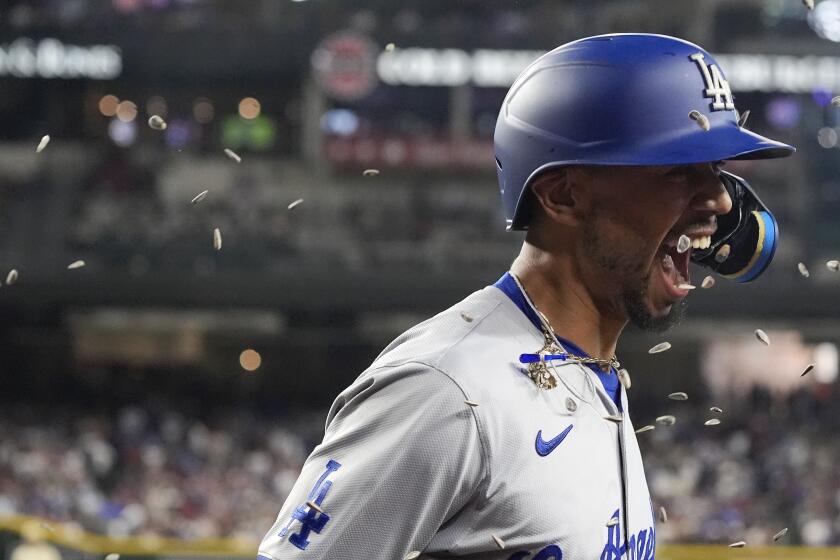Orange Coast crew takes on sport’s royalty at Henley regatta in England

The Orange Coast College crew team prepares to compete at the esteemed Henley Regatta in England next month.
The last few minutes were tough, the rowers going hard, finishing their early workout with a sprint.
Backs straight. Arms outstretched. Legs pumping with each clockwork stroke of the oars.
Their long, low boat cut through Newport Harbor on a morning that would be perfectly calm if not for their coach hovering alongside in a motorized launch, yelling at them through a megaphone.
“Finish,” he hollers. “Finish.”
The eight-man crew from Orange Coast College has been preparing all month for the race of their lives, a trip across the Atlantic to compete in the storied Henley Royal Regatta.
It will be a David-and-Goliath proposition.
Orange Coast is the only community college in the nation that maintains a high-level rowing program. As such, the Pirates go head-to-head with schools such as Notre Dame, Michigan and Virginia.
“We always have that chip on our shoulders, trying to prove ourselves,” coach Cameron Brown says. “We love that.”
The challenge will be even steeper against an international field on the River Thames in England. With qualifying Friday, recent practicesbenefited from an extra jolt of adrenaline.
During this morning’s final sprint, a freshman rower in the fourth seat resorted to mental tricks as he pushed through fatigue.
“Your legs are burning, everything is burning,” Cole Guild says. “I start counting the strokes to make it go by a little quicker.”
We always have that chip on our shoulders, trying to prove ourselves. We love that.
— Coach Cameron Brown

::
Someone donated an old racing shell — a boat — left over from the 1932 Los Angeles Olympics.
It was 1953 and Orange Coast decided to start a rowing team. Administrators worked a deal with the county, paying $1 a year to lease two Quonset huts on a sandy bank beside the harbor.
Even with these meager beginnings, there was reason to believe crew might someday thrive at the relatively new campus in Costa Mesa.
“This wouldn’t sell in Barstow,” says David Grant, a team member in the first years. “This community likes water sports, likes young people involved in those sports.”
Just as important, the college had Grant, who returned to teach history in the early 1960s. Summoned to the president’s office, he was asked to do something about rowing, a bare-bones operation.
“I don’t really know much about it,” Grant recalls saying.
The president’s reply: “I’m sure you’ll figure it out.”
One of the first things Grant did was write a letter to Harry Parker, the coach at Harvard. It was an audacious move — a small-time community college in California seeking advice from the Ivy League — but it worked.
The famously taciturn Parker invited Grant to hang around Crimson practices for a week, teaching him a common-sense methodology.
“What do rowers want from a coach? They want to go faster,” Grant says. “Don’t be a cheerleader. Just tell them how it works.”
This approach worked well at Orange Coast, which began fielding four- and eight-man crews to compete on the varsity and novice levels. The Pirates broke onto the national scene with a second-place finish at a 1968 national regatta and won a freshman title in 1980, the first of 11 national championships.
It helped that Grant, who served as an assistant on the U.S. coaching staff for the 1984 Summer Olympics, eventually became the college’s president.
The program made periodic trips to the Henley regatta and, in 1985, was invited to compete in China. The original Quonset huts were replaced by a modern boathouse with room for a quiver of expensive, German-made shells.
“They had a really strong program through the ’80s and ’90s,” says Matt Imes, the high-performance director for USRowing. “As a junior college, they performed well nationally.”


::
Time has always been an issue.
Major universities have four years to groom their rowers. The Pirates have two.
“We always have less experience,” says Axel Witt, a sophomore on the team. “That just makes it all the more challenging.”
Orange Coast has been able to establish a winning tradition for several reasons.
The program targets recruits who fall just below the top level, offering these young men and women two more years to improve and, in many cases, attract scholarships to bigger schools.
As for the remainder of the roster, those spots are filled by athletic bodies.
Though rowing involves specific technique — catch, legs, back, arms — it does not require years of repetition to compete at the college level. Physical attributes are perhaps more important.
“It’s very much a leverage sport,” assistant coach Steve Morris says. “You need someone who is 6 feet or taller, strong legs, big lungs.”
Basketball and volleyball players make good candidates, as do swimmers. Newcomers must be amenable to long hours in the gym, lifting weights and rowing on indoor machines called ergometers.
“There are still novices who come into the sport and are incredible athletes and are successful,” Imes says. “We will have a kid on the Olympic team every four years who started in their freshman year in college.”
Each fall, the Orange Coast program attracts as many as 70 students but usually loses 20 or so in the first few weeks.
“None of them know what they’re getting into,” Brown says of novices. “It’s a lifestyle change and it’s not for everyone.”
The Australian-born coach was hired in 2015 to restore tradition after a lull. Since 2008, the Pirates and other “club” teams — from schools that do not offer rowing scholarships — have been shifted to the fledgling American Collegiate Rowing Assn.
That puts Orange Coast in a different class from traditional powerhouses such as Cal, Washington and Yale. But it is still grouped with teams ranked in the coaches’ top 20.
The two-year limit might help in one way. Rowers such as Witt, who transferred from Hobart College in New York, say they can sense urgency when they step inside the boathouse.
Grant, who remains a presence around the team, puts it like this: “We don’t have a minute to waste. Not one. We’ve got to be smart and we’ve got to use every second.”
We always have less experience. That just makes it all the more challenging.
— Sophomore Axel Witt

::
The last 10 months have felt like a whirlwind for Guild, a 6-7 freshman who went from absolute beginner to earning a spot on the varsity crew.
While rowers at each end of the boat set the pace and keep balance, his No. 4 seat puts him in the “engine room” — the middle guys who provide muscle.
Guild still seems unsure about what to make of traveling to England this week.
“I didn’t really know what Henley was,” he says. “It seems like a pretty big deal.”
The regatta will serve as a farewell for veterans such as Witt, who received an athletic scholarship to George Washington, and Daniel Amado, who will row for UC San Diego next fall.
“The place is definitely a hidden gem in the rowing world,” Amado says of Orange Coast. “For a community college to offer all this, it’s remarkable.”
The Pirates have spent the week acclimating to conditions on the Thames, where the course is narrow, longer than normal and runs against the current.
That means extra work for Cambria Stirrat, who tucks herself into the stern as coxswain. With no oar in her hands, she keeps an eye on the opposing boat and dictates strategy, telling her rowers when to shift gears from a base tempo to a sprint.
“Henley is a very big coxswain race,” she says. “I’ve been doing a lot of research and watching videos and looking at maps.”
Though the Orange Coast team finished third overall behind Michigan and Virginia at the recent ACRA national championships, the eight-man boat that will compete at Henley could do no better than sixth.
So the Pirates will have to make it through qualifying to reach the main draw at Henley. Brown has told his rowers that their best times from this season should do the trick.
Still, nerves could play a role, especially at an event in which only two boats race at a time.
“My guys have never done anything like this before,” the coach says. “Hopefully we’ll get a crew we can beat.”
If nothing else, the rowers from a small campus in Orange County can fall back on something familiar.
“The underdog approach,” Amado says. “Maybe we can wow everybody.”
Twitter: @LAtimesWharton
Go beyond the scoreboard
Get the latest on L.A.'s teams in the daily Sports Report newsletter.
You may occasionally receive promotional content from the Los Angeles Times.




